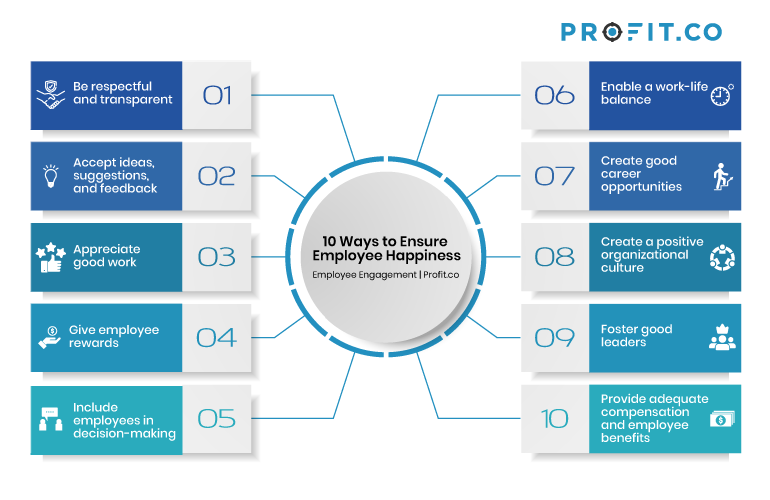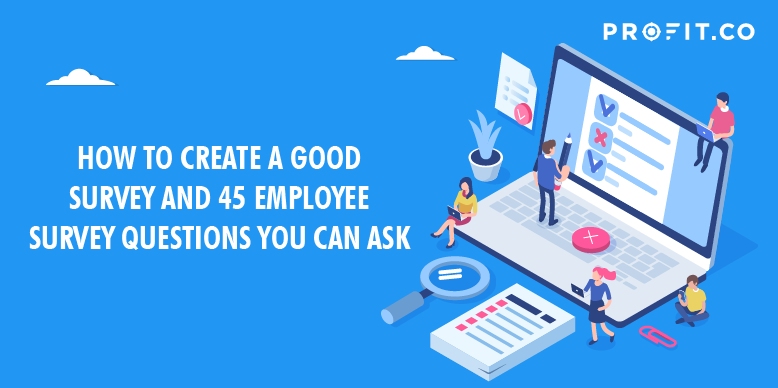Employees are the most important components of the organization. Employees working and merely completing the daily routine at workplace is not enough for the organization to be able to retain them and keep them working to their highest potential. Keeping them happy and engaged is crucial for improving productivity in the workplace and retaining employees.
Leadership is the ability to facilitate movement in the needed direction and have people feel good about it
Employee Surveys – the means to understand employees and the workplace
The responsibility for making this happen falls squarely on the HR team. They follow established research methods to understand what motivates employees to do their best, what keeps them happy, what their aspirations are, what affects their happiness, whether they feel one with the organization or not, etc. Employee Surveys are conducted for understanding these factors. Employee survey questionnaires are the tools for collecting data relevant to the research.
What is a good survey?
But conducting an employee survey is not easy and straightforward. It requires deeper understanding of the purpose of survey, the objectives and what outcomes you expect to achieve. A good survey is purpose-built to meet the objectives and bring out actionable insights on employee engagement or employee satisfaction. A bad survey may not give you the real picture of what the organization is like for the employees to work in. As a result, you may not be able to identify the issues and fail to achieve the objectives of the employee survey.
How can you create a good survey?
Creating the survey with careful and informed design is the first step towards a good employee survey. Following steps can help you design a good survey.

1. What are you planning to achieve with the employee survey?
Analyze the previous surveys and feedback from casual conversations with your employees to understand the potential problems that need to be addressed immediately to make employee experience better. Select one aspect of employee experience that you need to focus on, based on your findings. For example, your goal for the employee survey could be to understand the link between employee benefits and employee engagement. Identify the objective and build your survey around that.
2. Choose the when and how of the employee survey.
Some of the survey results could vary depending on when it is conducted. For instance, the end of year could keep employees in expectation for a promotion or a hike. If you conduct a survey on career development and employee engagement, the answers employees provide may not be neutral, as their answers could have an impact on their promotions. It is essential to conduct such a survey during a different time of the year. You can find the right tool to conduct your survey with utmost confidentiality and anonymity. That would allow the employees to answer freely without any bias or fear of being identified.
3. How are you going to measure to meet your objectives?
When you decide the objectives, brainstorm with your team to identify the metrics you need to measure in order to achieve your survey goals. With the right metrics, you will get a precise measurement of factors that contribute to the aspect of employee experience that you are studying.
4. Ask the right questions in the survey questionnaire.
In order to get the right answers, you need to ask the right survey questions in the first place in the employee questionnaire. Once you choose the metrics to measure, frame the questions accordingly, and make sure all the questions are relevant to your objectives of the survey.
5. Measure behavior and not intentions
When you ask questions about a thought or a motive or intention, it creates room for judgement and subjective views. For instance, while conducting an employee survey on Employee relationship with the organization’s leadership, if you ask, “Does your manager think about your career progress?”, it can bring out conflicting answers from the participants. Instead, you can ask, “Does your manager arrange the trainings and skill development sessions that you need to reach the next level in your job?”. This will evoke a clear and straightforward answer that depict behavior rather than the manager’s intentions, as the answers will be based on observable facts rather than assumptions.
6. Keep the employee survey short and focused
Employees need to participate enthusiastically to make any employee survey a success. Keep the survey short and focused on the objectives to keep the employees interested in participating in the survey. After all, only if the employees participate enthusiastically and complete the survey you will have data that is representative of truth.
7. Categorize the questions when you create an employee survey template.
When you have different aspects of employee experience to measure, categorize the questions for a good logical flow as well as to get more coherent replies. This will also help in making the consolidation of data and analysis easy and the outcomes more meaningful. While framing the employee survey questions, make sure that the participants will spend equal amount of time on each category to avoid giving too much importance to just one aspect of what you are trying to measure.
8. Ask clear, unambiguous questions that bring unbiased answers.
Use a simple and Clear language to frame the questions so that the participants can easily understand them and provide answers that are consistent and objective.
9. Mix close-ended questions, open-ended questions and feedback.
Get your measurements quantitatively with some questions; let the participants quickly get through the survey questionnaire using some closed ended yes/no questions; and give employees a space for speaking out through employee feedback spaces. A mix of these three can help you get good outcomes with complete engagement from participants.
10. Have a clear and consistent rating scale across the employee survey questionnaire.
When you want to measure certain aspects of employee experience, make sure the ratings are based on a singular rating scale that remains consistent across the whole survey questionnaire. This will avoid confusion and provide the right rating.
Sample questions you can ask in an employee survey questionnaire
While designing a survey, you can ask some of the following questions.
Internalizing goals
- Do you find your work to be meaningful?
- Do you find the purpose of your work to coincide with the organization’s goals?
- On the scale of 0-10 how much does your work contribute to the organization’s success?
- Do you feel inspired by the mission and objectives of your organization?
- Has the management communicated a vision that boosts your morale?
Career Growth
- What are your career goals?
- When was the last time you were promoted?
- Do you feel that the organization is providing you with new opportunities?
- Have you received trainings to develop new skills/upgrade your skills?
- How often have you received trainings?
- Do you think you have had enough learning opportunities in the organization?
- Mention the trainings you want to get enrolled this year.
- Where do you imagine yourself to be in the organizaton after five years?
- Have you attended interviews for a new job outside the organization?
- If yes, which aspect of that company was attractive to you?
- Has your career progressed according to your plan?
- On the scale of 0 to 10, rate the organization for the career opportunities it has created for you.
- On the scale of 0 to 10, rate the organization for the career growth it has offered you.
Job Satisfaction
- On the scale of 1 to 10, how happy are you with your job?
- What was your most recent achievement at work?
- What is your source of motivation?
- Do you love your job?
- On the scale of 1 to 10, how much do you like the responsibilities allotted to you?
- Do you want to take up more work?
- Does your job involve challenges suitable for your profile?
- Mention five reasons for your satisfaction in your work.
- Mention five reasons for your displeasure at work.
- In a scale of 1 to 10, how likely are you to refer someone you know to join the organization?
- Are you happy with the employee benefits offered by the organization?
- Mention one essential employee benefit that you would like the the organization offer in the future.
Organization, its culture and climate
- What are the qualities of the organization that you like?
- On the scale of 1 to 10, how would you rate the friendliness of your workplace?
- What is the one quality that you would like for the organization to retain?
- What in your opinion are the things that the organization needs to change?
- On the scale of 1 to 10, how would you rate the purpose of the organization?
- Are you proud to be a part of this organization? Explain why.
- Mention five differences you see in the organization in terms of employee experience since you joined.
- Give three reasons for why you want to be with us.
- Give three reasons that would make you look for opportunities outside the organization.
Superiors and Management
- Do your superiors listen to you?
- Does your manager accept your ideas?
- Does your manager recognize your work?
- On a scale of 1 to 10, how well do your superiors recognize your work?
- Do your superiors communicate your goals clearly?
- On the scale of 1 to 10, how likely are you to suggest ideas and give feedback to your superiors?

